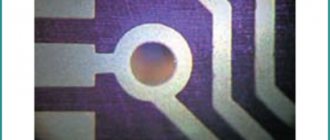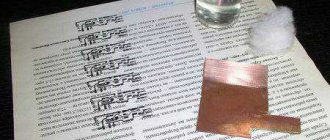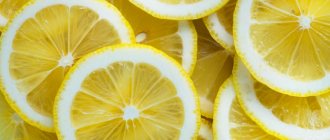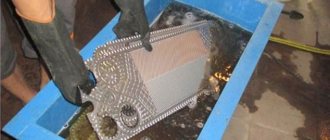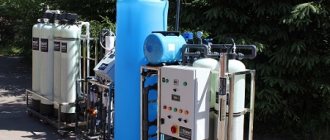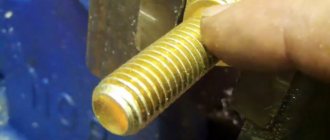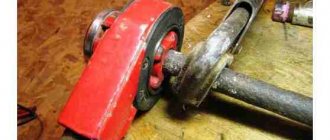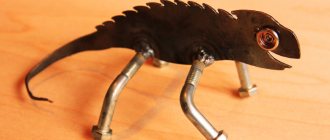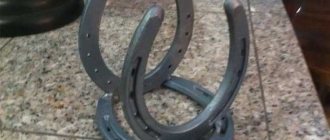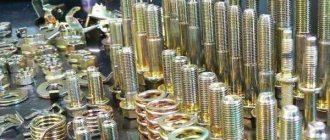Drawing
If you are considering this method as an artistic idea if you want to decorate a knife or other element by etching metal at home with salt, then you need to protect and isolate certain areas. You can even achieve halftones, then some protective films must be left for the entire period, and others must be removed as the main background is etched. Let's consider what available methods can be used to secure the pattern area.
Nail polish
Among the advantages are ease of application and accessibility; it can be easily found in your spouse’s cosmetic bag or bought for a penny. But there are disadvantages:
- It is difficult to make too thin lines due to the high viscosity;
- it is difficult to carefully erase accidentally drawn elements;
- artistic skill required.
Primer or bitumen varnish
Since etching a design on metal with your own hands without a stencil is not easy, the easiest method is to completely prime the surface, and then draw a pattern with a sharp part, removing the excess. Don't apply too much pressure or you risk scratching the steel.
Glossy paper
There is special material for creativity, but a sheet from a magazine will also work. The pattern should be printed on it in a mirror image using an inkjet printer. Then the freshly printed design must be attached to the area to be treated and ironed with an iron. After cooling, moisten the area with warm water and remove the paper - the mark will be transferred.
Stainless steel processing methods: the most popular options
Processing of stainless steel, which can be performed using various methods and technologies, allows not only to provide products made of this metal with the required parameters and quality characteristics, but also to give their surface an attractive appearance. By correctly selecting and using various processing methods, stainless steel alloys are used to produce products for various purposes that fully meet the requirements for them. Mechanical processing of stainless steel with electric tools allows you to quickly remove roughness from the surface
You might also be interested
One of the traditional methods of ensuring moisture protection of products for more than half a century has been filling cavities with sealants and compounds. Moisture entering electronic components in the form of drops, jets or moist air causes both immediate failures and acceleration of corrosion processes. Fuels, acids or acid gases can have an even more destructive effect. Therefore, such a fill should have a high
The constant miniaturization and increasing complexity of printed circuit boards entails a decrease in the diameter of the holes being plated while increasing the thickness of the printed circuit boards. Compaction of the circuit pattern leads to an increase in the number of MPP layers and a decrease in the width of the conductors. The increasing ratio of PCB thickness to plating hole diameter requires process suppliers to improve PCB plating processes to ensure consistently high quality and reliable production.
What will you need for work?
According to experts, you can blacken aluminum using this method at home. However, first you need to acquire the necessary equipment and materials. First of all, prepare a source of electric current. A KBS-L battery rated at 4.5 volts is quite suitable for this purpose. Some craftsmen recommend 9-volt Krona batteries. You can also use a car battery or a low-power 12-volt rectifier.
To be able to regulate and smoothly stop the process, you will need a rheostat. The electrolyte solution will be contained in a neutral glass container or wide plastic container. It will be possible to supply current to the solution through anodes.
Production of aluminum by electrolysis
Electrolytic reduction of aluminum oxide dissolved in a cryolite-based melt is carried out at 950-970 °C in an electrolyzer. The electrolyzer consists of a bath lined with carbon blocks, to the bottom of which electric current is supplied. The liquid aluminum released on the hearth, which serves as the cathode, is heavier than the molten salt of the electrolyte, therefore it is collected on a coal base, from where it is periodically pumped out (Figure 4). Carbon anodes are immersed in the electrolyte on top, which burn in an atmosphere of oxygen released from aluminum oxide, releasing carbon monoxide (CO) or carbon dioxide (CO2). In practice, two types of anodes are used:
- self-burning Zederberg anodes, consisting of briquettes, the so-called “bread” of Zederberg mass (low-ash coal with 25 - 35% coal tar pitch), stuffed into an aluminum shell; under the influence of high temperature the anode mass is burned (sintered);
- baked, or "continuous", anodes made from large carbon blocks (e.g. 1900 × 600 × 500 mm weighing about 1.1 t).
Figure 4 – Electrolyzer diagram
The current strength in the electrolysers is 150,000 A. They are connected to the network sequentially, i.e., a system (series) is obtained - a long row of electrolysers.
The operating voltage on the bath, 4–5 V, is significantly higher than the voltage at which aluminum oxide decomposes, since voltage losses in various parts of the system are inevitable during operation. The balance of raw materials and energy when producing 1 ton of aluminum is presented in Figure 5.
Figure 5 – Balance of raw materials and energy when producing 1 ton of aluminum
In the reaction vessel, aluminum oxide is converted first to aluminum chloride. Then, in a tightly insulated bath, electrolysis of AlCl3 dissolved in the molten salts KCl and NaCl occurs. The chlorine released during this process is sucked off and supplied for recycling; aluminum is deposited on the cathode.
The advantages of this method over the existing electrolysis of liquid cryolite-alumina melt (Al2O3, Na3AlF6 dissolved in cryolite) are: saving up to 30% of energy; the possibility of using aluminum oxide, which is not suitable for traditional electrolysis (for example, Al2O3 with a high silicon content); replacing expensive cryolite with cheaper salts; disappearance of the danger of fluoride release [7].
What is etching
This is a technology for removing the top layer from the surface of a metal part. The technology is used to clean workpieces from scale, rust, oxides and remove the top layer of metal. Using this method, the top layer is removed to search for internal defects and study the macrostructure of the material.
Using etching, they clean the part and increase surface adhesion. This is done for the subsequent connection of the metal surface with another workpiece, before applying paint, enamel, galvanic coating and other protective coatings.
The method allows you not only to quickly clean the part, but also to create the desired pattern on the metal surface. Using this method, the finest channels and complex images are cut out on a metal surface. You can clean large parts or rolled products. The processing depth is adjustable with an accuracy of several microns, which makes it possible to produce complex parts with small grooves and other complex elements.
Acid etching of aluminum
Due to the fact that very strong acids are used in this process, it is first of all necessary to take increased precautions when working with them. The operator must wear gloves, a mask, an apron
It is important that the room where the process itself takes place is well ventilated. Without certain skills and without certain protective equipment, it is not recommended to work with acids
As noted above, the aluminum product is placed in a container with acid. The most common reagents used for chemical etching of aluminum with acid are hydrochloric or sulfuric acid. When they interact with metal, hydrogen is released. Externally, it looks like this: the surface of the product is covered with small bubbles. But, in principle, this can be prevented if you add a special ingredient to the container in advance. This way the metal will be protected from bubbles by a thin film.
A very important point: all operations for etching an aluminum product with acid must be performed intensively so that the surface of the metal itself remains intact.
The described method is recommended to be carried out in containers made of wood or concrete. In this case, its inner surface should be lined with acid-resistant tiles so that the walls of the container do not corrode.
This method is not used very often in practice.
Further processes occurring during etching with alkali
During this process, the amount of caustic soda gradually becomes less. And thus the speed of the process itself decreases, but the viscosity increases.
Provided that no sodium hydroxide was added to the container at all, the reaction can slow down very much. But eventually the brownish or clear aluminum etching solution turns white.
And from this moment on, the speed of the process increases.
As a result of the reaction, aluminum oxide hydrate precipitates, which looks like a suspension. Caustic soda is also released, which is also necessary for the etching process to continue.
Acid etching of aluminum
Due to the fact that very strong acids are used in this process, it is first of all necessary to take increased precautions when working with them. The operator must wear gloves, a mask, an apron
It is important that the room where the process itself takes place is well ventilated. Without certain skills and without certain protective equipment, it is not recommended to work with acids
As noted above, the aluminum product is placed in a container with acid. The most common reagents used for chemical etching of aluminum with acid are hydrochloric or sulfuric acid. When they interact with metal, hydrogen is released. Externally, it looks like this: the surface of the product is covered with small bubbles. But, in principle, this can be prevented if you add a special ingredient to the container in advance. This way the metal will be protected from bubbles by a thin film.
A very important point: all operations for etching an aluminum product with acid must be performed intensively so that the surface of the metal itself remains intact.
The described method is recommended to be carried out in containers made of wood or concrete. In this case, its inner surface should be lined with acid-resistant tiles so that the walls of the container do not corrode.
This method is not used very often in practice.
Types of etching
There are two main types of etching of metals in general and aluminum in particular: chemical and galvanic. The last method is just artistic.
For chemical use: the product is placed in a container into which a solution of hydrochloric or sulfuric acid has been previously poured. In the same way, the aluminum workpiece is etched with an alkali, for example caustic soda.
And galvanic (otherwise known as electrolytic or electrochemical) occurs thanks to an electric battery. The process itself is carried out in a special bath, where there is an anode and a cathode.
Next, each of the aluminum etching methods will be discussed in more detail. We will also find out which method is the safest at home.
Steel pickling
This treatment is mainly used to remove scale and various oxides. This procedure requires careful adherence to technology, since over-etching of the base metal is undesirable. The process uses both chemical methods and electrolyte baths. Hydrochloric and sulfuric acids are used to prepare solutions. All parts require thorough degreasing of the surface. Even a small fingerprint can ruin the workpiece. A varnish based on rosin, turpentine, and tar is used as a protective coating.
However, it is worth remembering that the components are flammable substances, so preparing the varnish requires great concentration and caution. After the metal processing is completed, the etching process itself occurs.
Upon completion, the part must be cleaned of varnish.
The essence of the method
Metal etching involves careful surface treatment. A protective coating is applied to the product, which is erased in the place of the design. Then either acids or an electrolyte bath are used. Unprotected places are destroyed. The longer the exposure time, the deeper the etching of metals occurs. The drawing becomes more expressive and clear. There are various ways to obtain an engraving (inscription): the image itself or the background can be etched directly. Often such processes are combined. Multilayer etching is also used.
Pickling of non-ferrous metals
Copper and alloys based on it are etched using sulfuric, hydrochloric, phosphoric or nitric acids. The process is accelerated by solutions of chromates or nitrates. The first stage is the removal of scale, then the brass is directly etched. Aluminum (and its alloys) are etched in a caustic alkali solution. For casting alloys, nitric and hydrofluoric acids are used. Spot welded workpieces are treated with phosphoric acid. Titanium alloys are also etched in two stages. First - in caustic alkali, then in a solution of sulfuric, hydrofluoric, nitric acids. Titanium etching is used to remove the oxide film before electroplating. Molybdenum is treated with a solution based on sodium hydroxide and hydrogen peroxide. In addition, metals (such as nickel, tungsten) are etched using water, hydrogen peroxide and formic acid.
↑ We show
Next is development. We prepare a solution for development from: 0.5 l household glass jar - 1 pc., soda ash (not baking soda) - 0.5 teaspoon, hot tap water - 0.5 l (full jar). Stir the solution until the soda is completely dissolved. Then we take a not very hard clothes brush, dip it into the solution more often and brush it almost without pressing over the photoresist. The unexposed photoresist is gradually washed off and the following picture is obtained:
Rice. 9. Developed photoresist.
Features of this method
The solutions used contain from four to ten percent sodium. The temperature when etching with alkali is approximately 40-90 degrees Celsius.
If necessary, a moisturizer or special additive is used to obtain a light foamy coating on the workpiece.
The average temperature at the height of the process is sixty degrees. It is at these thermal parameters that high-quality surface cleaning occurs.
The optimal purity of aluminum is 99.5%, and the concentration of caustic soda solution is 10, 15, or 20%.
Thus, during the reaction, aluminum dissolves in sodium hydroxide, releasing hydrogen. As a result, a composite aluminate is formed, and it exists only in an alkali solution.
Results with the method under consideration
It has been experimentally established that a solution of caustic soda, when used intensively during the etching process, begins to “absorb” aluminum. And this happens until the amount of caustic soda decreases to one-fourth of the original volume. And after this, the process will continue with free caustic soda, fluctuating in its quantity. And this, in turn, depends on temperature, frequency of use and intensity of stops (pauses).
In this case, the hydrate will slowly settle into sediment or form crystals at the bottom and/or sides of the container. The resulting hydrate will be quite dense and will not be easy to remove. Sometimes it tries to settle right on the surface of the heating coils.
There is another important point regarding the aluminum content. When etching products made of this metal in caustic soda, it is necessary to strictly observe the ratio of the amount of aluminum and soda. Because the more aluminum there is, the slower the process itself will occur. From a practical point of view, it becomes clear that it is necessary to constantly increase the amount of caustic soda as the amount of aluminum in the container increases.
Thus, the process of etching aluminum with alkali can be continued continuously. And losses of caustic soda will occur only due to its entrainment with steam.
This method is really applicable from a practical point of view. But there are several nuances that should not be forgotten: remove the hardened hydrate sediment from time to time; clean the filter; remember that the container in which the process is carried out, with constant use, can last no more than two years.
Otherwise, no complications regarding the use of this method were identified.
In total, after chemical etching of an aluminum workpiece, it is necessary to thoroughly rinse its surface, neutralize and lighten it with a 15-20% solution of nitric acid. This process is called pickling.
↑ Idea
The milling machine ordered aluminum buttons. The case was purchased from a store. And then the question arose of how to make indelible inscriptions on the buttons and body. I tried to scratch it and fill it with paint. It came out completely “meh”! Can be engraved! So I don’t have a Dremel, but I can’t help but search through friends. Laziness, my friends, is the most powerful engine of progress. After some thought, I remembered that I had once accidentally dripped ferric chloride onto an aluminum radiator. While I wiped away the drop, there was a stain on the radiator and a small indentation. Yeah...
What if you make a stencil from photoresist and then etch it? The guinea pig was a piece of duralumin plate. Everything turned out great!
Aluminum etching with alkali
Most often, this method uses an aqueous solution of caustic soda (an option with or without additives is possible).
And it is used to clean the surface of an aluminum product from oxide or unnecessary lubricant and obtain a smoother (matte or glossy) surface.
Why is it necessary to clean so thoroughly? To ensure that the finished product (for example, decorative architectural elements, signs) has an ideal surface. This method is also used for deep engraving.
The method of etching aluminum with alkali, on the one hand, is quite inexpensive, but it is very labor-intensive.
White etching coating
Description of the defect
White etching appears as a non-uniform white layer on aluminum profiles made from 6xxx series alloys after alkaline etching. The white layer occurs as a result of non-uniform etching of aluminum in caustic soda solutions due to the presence of a MgO/Al2O3 film on 6063 alloy aluminum profiles when they are quenched in air.
Magnesium oxide is difficult to dissolve in caustic soda solutions, and therefore areas of increased roughness appear on the surface of the aluminum profile, which scatter visible light well and give the surface a white color.
Figure 2 shows such a defect on a profile made of aluminum alloy 6063. The dark spots represent places where the magnesium oxide film was removed during internal movement of the profile and on which, after a certain time, “finger” corrosion also formed.
Figure 2
Defect Prevention:
- Processing aluminum profiles in a hot neutral degreasing (non-corrosive) solution or
- Treatment of aluminum in a brightening acid solution before alkaline etching. In both cases, the formation of a defect is prevented by removing the magnesium oxide layer.
Process description
The point of the aluminum etching reaction is to remove a thin layer of metal from the surface. In industry, this is how they get rid of cracks, chips, scratches and oxide film on the surface. The procedure helps prepare the metal for further processing.
When it comes to chemical etching, aluminum is dissolved by acid or reduced to alkali. The holding time of the metal depends on the solution and is always strictly standardized. If the reaction time is not observed, the solution will remove too much metal. Within the industrial sector, losses of a few grams per reaction can grow into total losses of tens or hundreds of tons.
If we are talking about artistic grass, then the electrolytic method is more often used, which involves the reduction of aluminum in an electrolyte solution. In order to create an inscription on the metal surface, it is first coated with a protective compound or film. A prerequisite is that the film adheres tightly to the metal surface. The next step is to make a hole in the film or composition in the shape of the future engraving. As a result of an electrochemical reaction, the solution collects metal exclusively from the future inscription. The reaction time for aluminum art etching is also limited; too deep engraving can cut your fingers.
Both in home creative environments and in industry, the use of protective equipment is mandatory. If we are talking about a chemical process, the following personal protective equipment is required:
- Thick rubber gloves.
- Respirator with eye protection.
- Apron.
It is also worth remembering that acid baths are made of wood or concrete; the service life of one bath does not exceed 2 years, regardless of the activity of use. Aluminum etching solution
Chemical weeding can be carried out in the following solutions:
Ferric chloride. Etching aluminum in ferric chloride involves the active process of releasing the metal into acid and its deposition at the site of etching. This means that the engraved area will have to be constantly cleaned to free it for further reaction. Therefore, in industrial conditions, ferric chloride is used very rarely for etching. But the solution is quite suitable for home use. Etching should be carried out at a rate of 0.1 mm per minute. Engravings with a depth of 0.5 mm, filled with paint, look quite aesthetically pleasing. Caustic soda. Etching aluminum with caustic soda involves the use of household chemicals. The most suitable is the dry variation of the anti-sewer blockage product “Mole”. A standard package of the product is poured into a faceted glass of warm water and etching is performed. For a beautiful engraving or cleaning a metal surface, 3-4 minutes of reaction is enough
Please note that the reaction produces harmful gases and should therefore be carried out in a well-ventilated area. The optimal solution temperature is 70-80 degrees. Orthophosphoric acid
Etching aluminum with phosphoric acid involves the use of 10-20% phosphoric acid. For the reaction, the solution is heated to 40-50 degrees. Depending on the initial state of the metal, the reaction takes from 40 seconds to 2-3 minutes. The use of alkalis, orthophosphoric and hydrochloric acid is unacceptable in electrical engineering. If in the future you plan to use an aluminum part for use in electrical components or homemade radio assemblies, it is better to use a different etching mixture. Nitrogen. Nitric acid etching is not suitable for use in artistic engraving. Nitric acid is used, usually after alkali or to prepare the surface before painting. As a result of etching of metal in alkali, a dark layer of metal sludge is formed on the surface, which is formed as a result of the reduction of the metal into the volume of the alkaline solution. In order to give the product an aesthetic appearance, a 15-20% solution of nitric acid is used. Optimal etching is at room temperature of the solution. 2-5 minutes are enough for the entire reaction.
As mentioned earlier, an oxide film forms on the surface of aluminum. Most chemical solutions are used for the so-called brightening of the metal surface. In other words, to remove sludge from past manipulations or prepare the metal for future processing.
For home etching, you can use acids. But for artistic engraving it is better to use the electrolytic method. Also, when using acids, it is worth considering the requirements for room ventilation.
Method of blackening aluminum with ferric chloride
I needed to blacken a couple of duralumin rings for macrofur and a couple of aluminum adapters. For such a small number of parts, 15-20 grams of ferric chloride is sufficient.
Ferric chloride in a container for preparing a solution
First you need to dilute it with a small amount of water. For such a small amount of iron, very little water is needed. It is important that the resulting mixture is thick. so that it does not spread but is spread on the surface. I did it by eye - the thicker the solution, the better.
While the solution is “infused,” we prepare our parts for blackening. We clean them from possible dirt and dust and degrease them. I just washed them with soap under the tap, that was enough.
Now that the solution is ready, take some kind of stick. for example, for cleaning ears with cotton wool on the tip. and carefully coat the inner surfaces of the adapter. I only ink them, preferring to leave them shiny on the outside. Make sure that the solution remains on the surfaces and does not run off.
Part with ferric chloride solution applied
In my case, the aluminum parts turned black after 7-10 minutes. The duralumin took a little longer to darken, maybe 20 minutes, but I didn’t track the exact time.
The duralumin ring has darkened
As a result, the surface became dark gray and matte. Doesn't glare, which is what we wanted.
If you are not satisfied with the result, you can rinse the parts and go through again with the remaining solution. I did this with duralumin, steel and brass, in the hope that it would turn out better.
Dural began to look noticeably better, steel and brass remained the same. You can also leave them spread for a longer time.
After achieving blackening, the parts can be washed with running water and dried. Then you can use them.
The surface of the same ring after washing and drying. I'm happy with the blackening.
After I blackened the macro bellows ring, which was initially shiny, the contrast in the photos improved a lot, especially when shooting black details with long exposures.
Another aluminum part, blackened using the same method
But what happened to the brass: It didn’t darken at all, but became dull and changed color a little
Here is a relatively simple and high-quality blackening method. I hope that it will be useful not only to me, but also to other enthusiasts.
The most commonly used agent for etching aluminum is an aqueous solution of caustic soda with or without additives. It is used for general cleaning where oxide, grease or sub-surface debris must be removed with longer etching times to achieve a glossy or matte finish. It is used in the production of nameplates or decorative architectural elements, for deep engraving or chemical etching. This etching method is quite cheap, but at the same time it can become too complex to perform.
Solutions for decorative etching can contain from 4-10% or more caustic soda, the operating temperature will be 40-90ºC, and it may also be necessary to use a wetting agent to disperse grease and to obtain a light foam coating, as well as to use other additives. The normal operating temperature for cleaning and decorative processing is 60ºC. The figure shows the metal removal rate at various concentrations and temperatures during a 5-minute etching of 99.5% aluminum sheet. These curves apply to a freshly prepared solution, with lower values referring to the period after aluminum is immersed in the solution. Springe and Schwall published data regarding the etching rates of 99.5% pure aluminum sheet extruded 6063 in 10, 15, 20% sodium hydroxide solutions at temperatures ranging from 40 to 70ºC. Chaterjee and Thomas also conducted a detailed study of caustic soda etching of extrusion 6063 and sheets 5005, 3013.
Etching rate of 99.5% aluminum in caustic soda.
Aluminum dissolves in caustic soda, releasing hydrogen and forming a compound aluminate, which exists only in an alkaline solution. The reaction occurring in this case can be written in two ways:
The amount of free caustic soda decreases as the reaction proceeds, along with this the etching rate decreases, electrical conductivity decreases, and viscosity increases. If no caustic soda is added to the bath at all, the reaction proceeds very slowly, but eventually the clear or brownish solution becomes milky white, from which point the etching rate begins to increase again, and grows to a value slightly less than initial etching speed. The reaction observed at this stage can be written as follows:
The formed aluminum oxide hydrate or Gibsite has the form of a suspension, and during the reaction, caustic soda is also released, which is so necessary for the continuation of etching.
The ionic structure of aluminate in solutions with a high pH level is a rather complex issue; fortunately, this problem does not actually concern the operator. Moolenaar, Evans and McKeever conducted studies of the infrared and Raman spectra of solutions of sodium aluminate in water and deuterium oxide (heavy water), and they also studied the nuclear resonance spectrum of Na and Al. For aluminum concentrations below 1.5 M, they derived 4 vibration zones, two of which were infrared active at 950 and 725 cm-1, as well as 3 Raman zones active at 725, 625 and 325 cm-1. For aluminum there was also a thin resonance line. All these facts are quite easy to correlate with the existence of tetrahedral Al(OH)4-, which is the main carrier of aluminum in solution.
When the aluminum concentration exceeds 1.5M, a new vibration zone appears at 900 cm-1 for the infrared zone and the Raman zone at 705 and 540 cm-1, while the nuclear resonance zone for aluminum will be significantly expanded without changing position. All these observations can be explained in terms of condensation of Al(OH)4-, with increasing concentration and the formation of Al2O(OH)62-, and in solutions of 6 M sodium aluminate these two forms coexist in parallel. It was found that caustic soda solution, when used continuously, would absorb aluminum until the volume of free caustic soda was reduced to approximately one-quarter of the original volume, after which etching would continue with free caustic soda fluctuating at approximately the same level with amplitude , which depends on temperature, intensity of use and pause period. The hydrate will then slowly settle or crystallize on the bottom and sides of the tank to form a very hard hydrate which is very difficult to remove and unfortunately tends to settle on the surface of the heating coils. Here we observe the third reaction, i.e. dehydrogenation reaction of aluminum hydroxide to form aluminum oxide:
The nature of this transformation is shown in Fig. 4-10, where different amounts of aluminum are dissolved in a 5% (wt) solution of caustic soda, and measurements are carried out on free caustic soda immediately after each addition, as well as after three weeks. Up to 15 g/l of aluminum remains completely in solution without changing the amount of free caustic soda, but as soon as the precipitation of aluminum oxide begins, which occurs shortly before the appearance of a clearly visible precipitate, the free caustic soda is reduced to 4%, i.e. up to 80% of its initial value. With prolonged use, this value for such a solution can range from 1 to 1.5%, sometimes increasing to 2.5% in case of downtime lasting several hours. A similar ratio corresponds to a higher concentration of sodium hydroxide, and these values are virtually independent of temperature.
Effect of dissolved aluminum on free caustic soda.
Another important influence of aluminum is that as the aluminum content increases, the etching rate drops, quite clearly, this is reflected in the figure. In practice, this means that if it is necessary to maintain a constant etching rate, it is necessary to increase the free caustic soda content as the amount of aluminum in the bath increases.
The final reaction in this case will occur between aluminum and water with the release of hydrogen and aluminum. In theory, etching can thus continue indefinitely, with loss of caustic soda occurring only through entrainment. This method of working with a pickling tank is indeed applicable in practice, but one must remember that it is necessary to periodically remove the solid hydrate sediment. According to current experience, when operating in this mode, the service life of the tank can be up to 2 years. Filtration of caustic soda solutions has not been as successful due to the fact that very fine sediment tends to clog the filter very quickly, but otherwise no problems have been identified with this technique.
Etching rate in sodium hydroxide 50 g/l, sodium nitrate 40 g/l at 60ºС depending on aluminum concentration
.
Chemical control of the solution, used before precipitation or in a stable state after sedimentation, includes determination of total soda and free caustic soda. The content of the latter can be calculated with sufficient accuracy for practical use by titration with hydrochloric acid, which is carried out until the phenolphtolein indicator loses its color. As an alternative, potentiometric titration can also be suggested. To replenish losses due to entrainment, it is enough to only maintain the total content of caustic soda at a fixed level, since it is not possible to control the fluctuations of free caustic soda in the solution. For an accurate determination, in which carbonate and dissolved aluminum are also taken into account, a more complex calculation method is used, which is given in the table.
One of the most common problems with caustic soda etching is the tendency to cause pitting or "burning" of part or all of the part, which is accompanied by an increase in etching speed of up to 300%. This usually occurs in heavily loaded solutions that are used so intensively that they have no possibility of recovery. In this case, the hydrate crystallizes on the part, which leads to an increase in the intensity of local etching, an increase in temperature and an effect on grain boundaries, which has the properties of acid etching. It is sometimes quite difficult to avoid pitting in this type of solution when attempting to remove the anodic film. If this happens, then it is necessary to lower the temperature.
Thus, it can be seen that, despite the apparent simplicity of the etching process, in practice there can be many competing reactions that must be recognized to obtain a good result. The main factors responsible for etching are the content of free caustic soda in the solution, the presence and amount of additives in the bath, the temperature of the solution, as well as the aluminum content in the solution. The influence of solution composition has been discussed previously, but the temperature of the solution has a strong influence on the etching rate. This factor can usually be easily controlled, but in practice, due to the exothermic nature of this reaction, it is often necessary to cool the pickling baths, especially when they are in continuous use. Most pickling baths are used at temperatures between 55 and 65ºC, as transfer etch contamination may occur at higher temperatures, especially on sheet materials.
Popular Science, 3D Printers, Lasers, Chemistry
Consider aluminum. It's actually a fairly common metal that people want to engrave on. For example: key fobs, flash drives, cases for some mobile phones - all these are products with an aluminum coating.
What we know about aluminum is a metal that has a melting point of about 600 degrees Celsius, has high thermal conductivity and most often has aluminum oxide on its coating, which has a melting point of more than 1000 degrees Celsius. All this makes the engraving process not simple when it comes to heat treatment, but there is another option. Being a metal, it is a conductor, and if so, then no one has canceled the electrolysis process. Here is the very solution that we will tell you about! In other words, this process is called aluminum etching
. There's nothing complicated about it.
So, we need: - a current source of 9-12 volts. - ordinary table salt NaCl. - a container made of dielectric (plastic is fine). - a nail or any iron object. - water - an aluminum sample - and of course, a laser!
Thus, the solution may be as follows: 1. Prepare the pattern that you would like to apply to the aluminum surface.
For example, here is a raster image.
2. Degrease the aluminum surface so that there are no air bubbles, and cover it with tape, varnish, or paint (of your choice).
3. We place the aluminum product on our 3D printer and carry out the laser cutting process (to destroy the surface layer and thus create open areas).
5. We divide the source of electric current into 2 wires “plus” and “minus”. 6. We attach an iron object to the minus and lower it into the water solution. 7. We attach our object to the plus and also lower it into the solution. 8. Apply power to the current source.
9. The process of electrolysis (etching) in the solution has begun. Depending on the current strength and concentration of the solution, you can approximately estimate the time required for etching. Usually 3-5 minutes.
10. Remove the product from the solution.
In fact, it is worth remembering that the product that needs to be engraved must be carefully isolated before being placed in the solution, with the exception of those areas where, in fact, the engraving should be applied. This process can be carried out at home or in a small workshop. With this technology, anyone can become a metal (aluminum) engraver.
In our understanding, this is very practical and valuable knowledge. Please subscribe to Endurance updates! Engraving is easy!
Engraving aluminum at home:
Endurance DIY laser engraver demonstration:
Simple laser engraving:
More details on the website
EnduranceLasers.com, or EnduranceRobots.com and also by phone 8 916 225 4302 or Skype: George.fomitchev
Etching is a process in which part of the metal is removed from the surface by chemical means. This method is used for final processing of a part, when preparing a workpiece before applying a coating (electroplating), as well as for creating all kinds of drawings, ornaments and inscriptions.
Stainless steel pickling
Pickling stainless steel is an important process that ensures the removal of the top layer of material and restoration of the original state.
The bottom line is that after certain work is carried out, defects in the form of welds, oxides and scales can form on the surface of the stainless steel, which can significantly spoil the appearance of the material, as well as worsen the operational and aesthetic properties. A distinctive feature of steel is the presence of an oxide-chrome film, the purpose of which is to protect the top layer.
It is because of this that the above defects arise, which are difficult to interact with reagents. If such troubles occur, you can correct the situation by using a special procedure - etching stainless steel.
Stainless steel pickling procedure
Chemical and electrochemical treatment or etching is considered one of the best ways to clean the top layer of stainless steel.
This procedure perfectly cleans the steel surface from welds, eliminates various types of deformations, and also helps strengthen the structure of the alloy after heat treatment.
In addition to cleaning properties, the procedure ensures the restoration of the passive layer of steel, which is necessary to protect the alloy from structural destruction at elevated temperatures.
Typically, hydrochloric or sulfuric acid is used, after which a mixture of molten alkali is used.
The acid cleaning process has two stages: first of all, the metal is treated with a basic acid composition, and finally the alloy is kept in a bath with a solution of nitric acid.
When processing stainless steel, you should strictly follow the stages of the technological process. The container with the solution in which the alloy is placed should process only the upper layers of the metal, further eliminating existing damage. It is not recommended to allow changes in the macrostructure of stainless steel, as iron may lose its original properties.
Surface etching. Part 2
Etching of non-ferrous metals can be carried out both for final surface finishing with subsequent passivation (see “Decorative coatings”), and for preparation for the application of galvanic coatings.
Copper and its alloys
The etching of copper and its alloys is carried out in solutions based on sulfuric, nitric, hydrochloric or phosphoric acids, depending on the method of manufacturing the product. Large-thick scale formed during rolling or heat treatment lends itself well to etching with concentrated sulfuric acid, without etching the metal. The presence of even a small amount of nitrate or chromate solution in the etching solution accelerates the process of etching the metal itself.
Therefore, the etching of parts made of copper alloys is carried out in two stages: first, scale is removed in a solution of sulfuric acid (200 - 250 g/l) at a temperature of 50 - 800C, and then etching is carried out in a solution of a mixture of sulfuric and nitric acids with the addition of chlorides, soda. g/l:
Sulfuric acid 500 – 550
Nitric acid 650 – 750
Sodium chloride 5 – 10
The solution is intended for etching parts made of copper and brass.
The process of etching various metals is presented in more detail in our training course.
Removal of thermal scale from bronze alloys such as BrOF, BrB can be carried out at a temperature of 135 - 1450C by etching in a solution containing 450 - 600 g/l caustic soda and 100 - 200 g/l sodium nitrate, followed by treatment for 0.5 - 1 min. in concentrated hydrochloric acid.
Preliminary etching of heat-treated beryllium bronze can be carried out in a solution of sulfuric acid (80 - 100 g/l) with the addition of ammonium bifluoride (30 - 50 g/l) to the solution at a temperature of 40 - 500C.
Aluminum and its alloys
Etching of aluminum and its alloys is carried out in a solution (5 - 10%) of caustic alkali at a temperature of 20 - 400C, to which a solution of 0.5 g/l sulfanol NP-3 is added to reduce the release of gases formed during etching, and to prevent the formation dense sediment of alluminates, add 2.5 - 3.5 g/l sodium gluconate to the solution.
